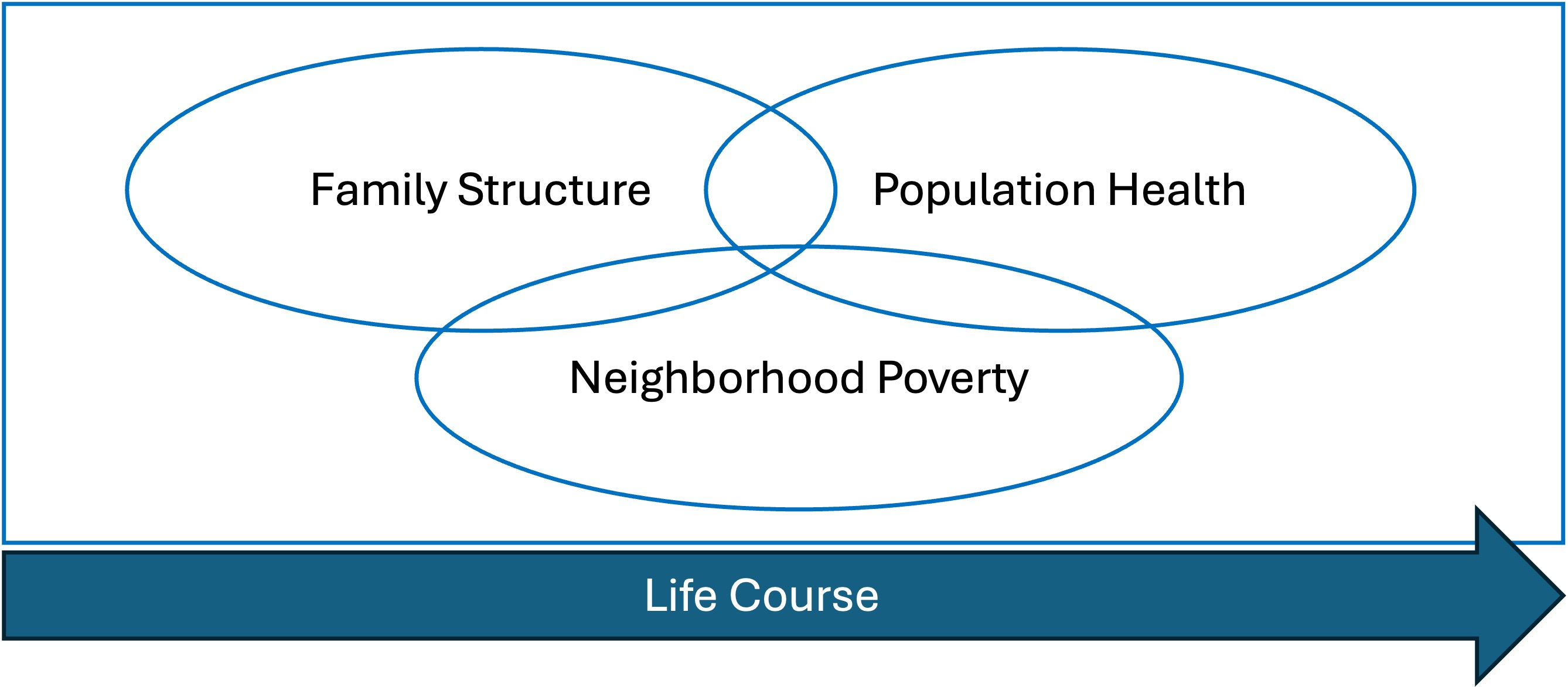Research (Selected Papers).
My research investigates the intertwined dynamics of family structure, neighborhood poverty, and health, emphasizing the reciprocal ways that social environments both reflect and reinforce patterns of well-being and life chances.

Health and Family Structure
It's Not What You Weigh, It's How You Present It: Body Size, Attractiveness, Physical Functioning and Access to Partnership and Sexuality for Older Men and Women
with Linda J. Waite. Social Forces, 104(2):776-802. 2025
Physical attractiveness has been linked to better economic, dyadic, and health outcomes but is understudied. We focus here on the gendered implications of attractiveness for one component of social well-being, access to intimate partnership and sexuality, among older adults. And we examine the role of body size as measured and as rated by an observer in evaluations of attractiveness and the diverging consequences for women and men. We use data from Rounds 1 (2005/06) and 2 (2010/11) of the National Social Life, Health, and Aging Project (N=2144) to explore the association of two measures of body size, weight relative to height (BMI), and interviewer assessments of body size, with sexual behavior that requires a partner and with sexual behavior that does not. We find that at larger body sizes as reflected in both BMI and rated body shape, women, but not men, face a lower probability of having a partner and engaging in partnered sex, and a lower frequency of vaginal intercourse and receiving sexual touch. These associations are mediated by physical functioning for BMI and by attractiveness as rated by the interviewer for rated body shape. We also find that women, but not men, are more likely to report finding sex not pleasurable at a higher BMI, which partly operates through the mechanism of functional limitations. We suggest that these findings reflect different attractiveness standards for men and women, which reduce women's access to partners and partnered sex but not solitary sex, such as masturbation.
Gender Differences in Associations Between Spousal Cognitive Decline and Marital Strain: Evidence from the U.S. Older Couples
with Meiyi Li and Michal Engelman. Social Science and Medicine
Despite extensive research demonstrating how marriage affects health, less is known about how health changes impact marriages, particularly when one spouse's health declines. This study extends the stress process model to dyadic contexts to ask whether and how one spouse's cognitive decline is associated with the other spouse's perceived marital strain, with attention to potential differences by gender. It also examines the influence of social support from family and friends, as well as social engagement and community participation on the dyadic dynamic. We estimated Actor-Partner Interdependence models with data (N = 620 couples) from Waves 2 and 3 of the National Social Life, Health, and Aging Project. Our results highlight gender asymmetries in dyadic stress processes. Wives reported higher marital strain when their husbands had dementia, while husbands reported lower marital strain when their wives experienced mild cognitive impairment and dementia. Friend support is associated with lower marital strain for wives whose husbands experience cognitive impairment, while socialization is related to higher marital strain for men whose wives experience cognitive impairment.
Rivalry or Solidarity: Influence of Siblings in Childhood on Cognitive Function and Cognitive Decline in Later Life
R&R at Demographic Research
Entwined Lives: The Dyadic Relationship between Childhood Adversity and Social Connectedness among Older Couples.
with Jason Wong and Linda J. Waite. R&R at Social Science Research
Health, Neighborhood Poverty, and Social Contexts
Neighborhood Poverty Trajectories and Health in Young Adulthood
with Geoffrey T. Wodtke. Work in Progress
Regional Homophily in Health Behaviors: Evidence from COVID-19 Vaccination Modeling in England with Social Network Theorem
with Xingzuo Zhou and Zejian Lyu. Journal of Computational Social Science, 2024
Social contagion is a key mechanism that shapes health behaviors, but few studies have applied this approach at the regional level to examine how vaccination beliefs and rates vary and diffuse across geographic areas. Through modifying the traditional SIR model, this paper addresses this gap by applying social network theory to a new compartmental model to simulate regional contagion in COVID-19 vaccination rates in England, using panel data of new and accumulated vaccination numbers from December 2020 to June 2022. The model estimates each region's initial and changing vaccination beliefs and their mutual influence on each other. The results reveal that Southeastern regions in England had higher initial vaccination beliefs and stronger spillover effects on other regions than northwestern regions. The paper suggests that policies to increase vaccination rates should consider the heterogeneity and peer effects among regions and other factors that may affect vaccination beliefs. The paper also discusses the limitations of the network model and directions for future research.